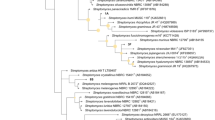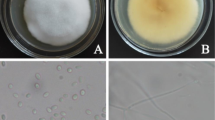Abstract
Morphological and molecular analyses of 25 actinomycete isolates from five commercial earthworm castings in Thailand indicated that all isolates belonged to the genus Streptomyces. From primary screens of spore suspensions and culture filtrates of the isolates for in vitro effects on egg hatch and juvenile mortality of Meloidogyne incognita, 12 isolates that gave significant control of M. incognita were confirmed to reduce root penetration by M. incognita in a secondary screen using green bean. The 12 isolates were also evaluated for their efficiency against root-knot disease on chili in the greenhouse. Streptomyces sp. KPS-E004 reduced the egg hatch rate the most (by 55.8 % using spores, 62.4 % using culture filtrate) and increased the juvenile mortality rate the most (by 63.9 % with spores, 73.9 % with culture filtrate). In the secondary screen, all infective second-stage juveniles of M. incognita treated for 72 h with a spore suspension of KPS-E004 lost the ability to penetrate plant roots. Moreover, this strain had the highest root-knot disease control efficiency on chili (71.2 %). Thus, Streptomyces sp. KPS-E004 has potential as a biocontrol agent to control root-knot disease in organic and sustainable agricultural systems.


Similar content being viewed by others
References
Barker KR (1985) Nematode extraction and bioassays. In: Barker KR, Carter CC, Sasser JN (eds) An advanced treatise on Meloidogyne, vol II., North Carolina State University GraphicsRaleigh, NC, pp 29–30
Byrd DW Jr, Kirkpatrick T, Barker KR (1983) An improved technique for clearing and staining plant tissue for detection of nematodes. J Nematol 15:142–143
Caillaud MC, Dubreuil G, Quentin M, Perfus-Barbeoch L, Lecomte P, Engler JDA, Abad P, Rosso MN, Favery B (2008) Root-knot nematodes manipulate plant cell functions during a compatible interaction. J Plant Physiol 165:104–113
Cliff GM, Hirschmann H (1984) Meloidogyne microcephala n. sp. (Meloidogynidae) a root-knot nematode from Thailand. J Nematol 16:183–193
Crawford DL, Lynch JM, Whipps JM, Ousley MA (1993) Isolation and characterization of actinomycete antagonists of a fungal root pathogen. Appl Environ Microbiol 59:3899–3905
Dicklow MB, Acosta N, Zuckerman BM (1993) A novel Streptomyces species for controlling plant-parasitic nematodes. J Chem Ecol 19:159–173
Dong LQ, Zhang KQ (2006) Microbial control of plant-parasitic nematodes: a five party interaction. Plant Soil 288:31–45
Edwards CA, Fletcher KE (1988) Interaction between earthworms and microorganisms in organic matter breakdown. Agric Ecosyst Environ 24:235–249
Edwards CA, Lofty R (1977) The biology of earthworms. Chapman and Hall, London
El-Nagdi WMA, Youssef MMA (2004) Soaking faba bean seed in some bio agents as prophylactic treatment for controlling Meloidogyne incognita root knot nematode infection. J Pest Sci 77:75–78
El-Nakeeb MA, Lechevalier HA (1963) Selective isolation of aerobic actinomycetes. Appl Microbiol 11:75–77
Food and Fertilizer Technology Center (2015) LT-M mixture for the management of plant parasitic nematode diseases. In: FFTC Publication Database. National Chung Hsing University, Taiwan. Available at DIALOG. http://www.fftc.agnet.org/library.php?func=view&id=20110901051121. Accessed 4 Aug 2015
Handoo ZA, Skantar AM, Carta LA, Erbe EF (2005) Morphological and molecular characterization of a new root-knot nematode, Meloidogyne thailandica n. sp. (Nematoda: Meloidogynidae), parasitizing ginger (Zingiber sp.). J Nematol 37:343–353
Hasegawa T, Takisawa M, Tanida S (1983) A rapid analysis for chemical grouping of aerobic actinomycetes. J Gen Appl Microbiol 29:319–322
Holt JG, Krieg NR, Sneath PHA, Stanley JT, Williams ST (1994) Bergey’s manual of determinative bacteriology. Williams & Wilkins, Baltimore
Jayasinghe BATD, Parkinson D (2009) Earthworms as the vectors of actinomycetes antagonistic to litter decomposer fungi. Appl Soil Ecol 43:1–10
Khamna S, Yokota A, Lumyong S (2009) Actinomycetes isolated from medicinal plant rhizosphere soils: diversity and screening of antifungal compounds, indole-3 acetic acid and siderophore production. World J Microbiol Biotechnol 25:649–655
Kumar V, Bharti A, Negi YK, Gusain O, Pandey P, Bisht GS (2012) Screening of actinomycetes from earthworm castings for their antimicrobial activity and industrial enzymes. Braz J Microbiol 43:205–214
Maldonado LA, Fragoso-Yáñez D, Pérez-García A, Rosellón-Druker J, Quintana ET (2009) Actinobacterial diversity from marine sediments collected in Mexico. Antonie Van Leeuwenhoek 95:111–120
Mishra SK, Keller JE, Miller JR, Heisey RM, Nair MG, Putnam AR (1987) Insecticidal and nematicidal properties of microbial metabolites. J Industr Microbiol 2:267–276
Mitra A, Santra SC, Mukherjee J (2008) Distribution of actinomycetes, their antagonistic behavior and the physico-chemical characteristics of the world’s largest tidal mangrove forest. Appl Microbiol Biotechnol 80:685–695
Park JO, El-Tarabily KA, Ghisalberti EL, Sivasithamparam K (2002) Pathogenesis of Streptoverticillium albireticuli on Caenorhabditis elegans and its antagonism to soil-borne fungal pathogens. Lett Appl Microbiol 35:361–365
Parthasarathi K, Ranganathan LS, Anandi V, Zeyer J (2007) Diversity of microflora in the gut and casts of tropical composting earthworms reared on different substrates. J Environ Biol 28:87–97
Pathma J, Sakthivel N (2012) Microbial diversity of vermicompost bacteria that exhibit useful agricultural traits and waste management potential. SpringerPlus 1:26
Ruanpanun P, Khun-In A (2015) First report of Meloidogyne incognita caused root knot disease of upland rice in Thailand. J ISSAAS 21:68–77
Ruanpanun P, Tangchitsomkid N, Hyde KD, Lumyong S (2010) Actinomycetes and fungi isolated from plant-parasitic nematode infested soils: screening of the effective biocontrol potential, indole-3-acetic acid and siderophore production. World J Microbiol Biotechnol 26:1569–1578
Ruanpanun P, Dame ZT, Laatsch H, Lumyong S (2011a) 3-Methoxy-2 methyl carbazole-1,4-quinone, carbazomycins D and F from Streptomyces sp. CMU JT005. FEMS Microbiol Lett 322:77–81
Ruanpanun P, Laatsch H, Tangchitsomkid N, Lumyong S (2011b) Nematicidal activity of fervenulin isolated from a nematicidal actinomycete, Streptomyces sp. CMU MH021, on Meloidogyne incognita. World J Microbiol Biotechnol 27:1373–1380
Saxena G (2004) Biocontrol of nematode-borne diseases in vegetable crops. In: Mukerji KG (ed) Disease management of fruits and vegetables. Kluwer, The Netherlands, pp 397–450
Sun MH, Gao L, Shi YX, Li B, Liu XZ (2006) Fungi and actinomycetes associated with Meloidogyne spp. eggs and females in China and their biocontrol potential. J Invertebr Pathol 93:22–28
Syers JK, Springett JA (2005) Earthworms and soil fertility. Plant Soil 76:93–104
Taechowisan T, Peberdy JF, Lumyong S (2003) Isolation of endophytic actinomycetes from selected plants and their antifungal activity. World J Microbiol Biotechnol 19:381–385
Tarkka MT, Hampp R (2008) Secondary metabolites of soil streptomycetes in biotic interactions. In: Karlovsky P (ed) Secondary metabolites in soil ecology. Springer, Berlin, pp 107–126
Tarkka MT, Lehr NA, Hampp R, Schrey SD (2008) Plant behavior upon contact with Streptomycetes. Plant Signal Behav 3:917–919
Vijayakumar R, Muthukumar C, Thajuddin N, Panneerselvam A, Saravanamuthu R (2007) Studies on the diversity of actinomycetes in the Park Strait region of Bay of Bengal, India. Actinomycetologica 21:59–65
Acknowledgments
The authors thank the Kasetsart University Research and Development Institute (KURDI) for financial support.
Author information
Authors and Affiliations
Corresponding author
Rights and permissions
About this article
Cite this article
Ruanpanun, P., Chamswarng, C. Potential of actinomycetes isolated from earthworm castings in controlling root-knot nematode Meloidogyne incognita . J Gen Plant Pathol 82, 43–50 (2016). https://doi.org/10.1007/s10327-015-0637-4
Received:
Accepted:
Published:
Issue Date:
DOI: https://doi.org/10.1007/s10327-015-0637-4




